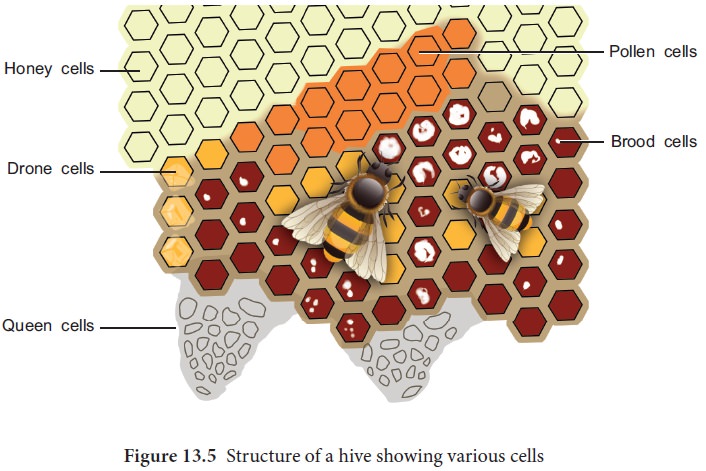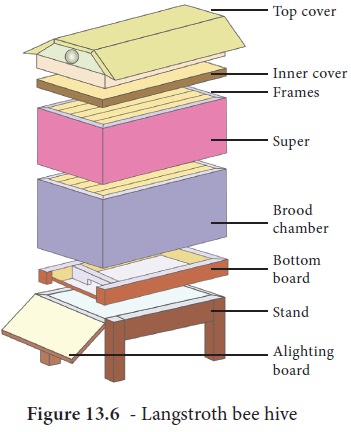Chapter: 11th Zoology : Chapter 13 : Trends in Economic Zoology
Apiculture

Apiculture
Ever since the beginning of civilization, man has
been trying to make use of organisms around him for various purposes and to
rear them for increasing their number. One of the finest discoveries is our
knowledge regarding the procurement of honey collected by honey bees. Care and
management of honey bees on a commercial scale for the production of honey is
called Apiculture or Bee Keeping. The word ‘apiculture’
comes from the Latin word ’apis’
meaning bee. Bees are reared in apiaries that are areas where a lot of bee
hives can be placed. There are five well recognized types of bees in the world.
They are Apis dorsata (Rock bee), Apis florea (Little bee), Apis indica (Indian bee), Apis mellifera (European bee) and Apis adamsoni
(African bee).
Social organization of honey bees
In honey bees, a highly organized division of
labour is found. A well developed honey bee colony consists of the
Queen, Drones and Workers (Figure 13.4). All the three types depend on each
other for their existence. There is normally one queen, 10,000 to 30,000
workers and few hundred drones (male bees) in a colony.

Queen bee
is a
functional female bee present in each hive and feeds on Royal Jelly. Its sole function is to lay eggs
throughout its life span. The virgin queen bee mates only once in her life.
During the breeding season in winter, a unique flight takes place by the queen
bee followed by several drones. This flight is called “nuptial flight”. The
queen bee produces a hormonal chemical substance called pheromone. The drones
in the area are attracted to the pheromone and mating takes place. During
mating, the drone releases large number of sperms for sufficient fertilization.
In a life span of two to four years, a queen bee lays about 15 lakh eggs. When
the queen bee loses its capacity to lay eggs, another worker bee starts feeding
on the Royal Jelly and develops into a new queen.
Among the honey bees, workers are sterile females and smallest but yet function as the main spring of the complicated machinery in the colony. Worker bee lives in a chamber called ‘Worker Cell’ and it takes about 21 days to develop from the egg to adult and its lifespan is about six weeks. Each worker has to perform different types of work in her life time. During the first half of her life, she becomes a nurse bee attending to indoor duties such as secretion of royal jelly, prepares bee-bread to feed the larvae, feeds the queen, takes care of the queen and drones, secretes bees wax, builds combs, cleans and fans the bee hive.
Then she becomes a soldier and guards the bee hive.
In the second half her life lasting for three weeks, she searches and gathers
the pollen, nectar, propolis and water.
The drone
is the functional male member of the colony which develops from an unfertilized
egg. It lives in a chamber called drone cell. Drones totally depend on workers
for honey. The sole duty of the drone is to fertilize the virgin queen hence
called “King of the colony”. During swarming (the process of leaving the colony
by the queen with a large group of worker bees to form a new colony) the drones
follows the queen, copulates and dies after copulation.
Structure of a Bee Hive
The house of honey bee is termed as bee hive or
comb. The hive consists of hexagonal cells made up of wax secreted by the
abdomen of worker bees arranged in opposite rows on a common base. These hives
are found hanging vertically from the rocks, building or branches of trees
(Figure.13.4). The young stages of honey bees accommodate the lower and central
cells of the hive called the brood cells.
In Apis dorsata, the brood cells are of similar in size and shape but in
other species, brood cells are of
three types viz., queen cell for
queens, worker cell for workers and drone cells for drones (Figure.13.5). The
cells are intended for storage of honey and pollen in the upper portion of the
comb whereas the lower portions are for brood rearing.

Methods of Bee keeping
The main objective is to get more and more quality honey. There are two methods used by apiculturists.
They are indigenous method and the modern method. In
indigenous method, the honey extracted from the comb contains wax. To overcome
the drawbacks of the indigenous method, the modern method has been developed to
improve the texture of hives. In India, there are two types of beehives in
practice namely, Langstroth and Newton. The Langstroth bee hive is made
up of wood and consists of six parts (Figure 13.6)

1) Stand is
the basal part of the hive on which the hive is constructed. The stands are adjusted to make a slope for rain
water to drain
2) Bottom
board is situated above the stand and forms the proper base for the hive.
It has two gates, one gate functions as an entrance while the other acts as an
exit.
3) Brood
chamber is the most important part of the hive. It is provided with 5 to 10
frames arranged one above the other through which the workers can easily pass.
The frame is composed of wax sheet which is held in vertical position up by a
couple of wires. Every sheet of wax is known as Comb Foundation. The comb
foundation helps in obtaining a regular strong worker brood cell comb which can
be used repeatedly.
4) Super is also a
chamber without cover and base. It is provided with many frames containing comb foundation to provide
additional space for expansion of the hive.
5) Inner
cover is a wooden piece used for covering the super with many holes for proper ventilation. 6) Top cover is meant for protecting the colonies from rains. It is
covered with a sheet which is plain and sloping.
Besides
the above primary
equipments, other accessory
equipments are used
in beekeeping Queen Excluder
is utilized to prevent the entry of queen bee from the brood chamber into the
super chamber. Comb foundation is a
sheet of bee wax, on
both sides of which the exact shape of different
cells of the comb is made in advance.
Bee
gloves are used by bee keepers for protecting their hands while inspecting the hives. Bee veil is a device made of fine nettings to protect the bee
-keeper from bee sting. Smoker is
used to scare the bees during hive maintenance and honey collection by
releasing smoke. Hive Tool is a flat,
narrow and long piece of iron which helps in scraping excess propolis or wax
from hive parts. Uncapping knife is
a long knife which helps in removing the cap from the combs as a first step in
honey extraction.
Bee brush is a large brush often employed to brush off bees from honey combs particularly at the time of extraction. Queen introducing cage is a pipe made of wire nets used for keeping the queen for about 24 hours for acquaintance with the hive and worker bees.
Feeder
is a basin with sugar syrup covered by grass to feed the bees during drought
season. The grass prevents the bees from sinking into the syrup. Honey Extractor is a stainless-steel device which spins the combs rapidly
to extract honey. Hive Entrance Guard is
a device similar to queen excluder in front of the hive entrance which prevents the escape of queen during warming season.
Products of bee keeping and their economic importance
The chief products of bee keeping industry are
honey and bee wax.
Honey is the
healthier substitute for sugar. The major constituents of honey are: levulose, dextrose, maltose, other
sugars, enzymes, pigments, ash and water. It is an aromatic sweet material
derived from nectar of plants. It is a natural food, the smell and taste depends
upon the pollen taken by the honey bee. It is used as an antiseptic, laxative
and as a sedative. It is generally used in Ayurvedic and Unani systems of
medicine. It is also used in the preparation of cakes, breads and biscuits
Bee wax is
secreted by the abdomen of the worker bees at the age of two weeks. The wax is masticated and mixed with the
secretions of the cephalic glands to convert it into a plastic resinous
substance. The resinous chemical substance present in the wax is called propolis which is derived from pollen
grains. The pure wax is white in colour and the yellow colour is due to the
presence of carotenoid pigments. It is used for making candles, water proofing
materials, polishes for floors, furniture, appliances, leather and taps. It is
also used for the production of comb foundation sheets in bee keeping and used
in pharmaceutical industries.
Related Topics